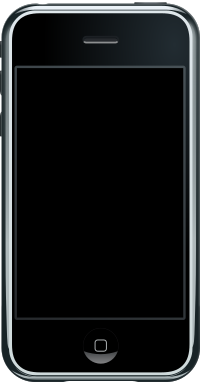 Front view | |
| Developer | Apple Inc. |
|---|---|
| Manufacturer | Foxconn[1] |
| Type | Smartphone |
| Generation | 2nd |
| First released | July 11, 2008[2] |
| Discontinued | June 7, 2010 |
| Units sold | 1 million over first weekend[3] |
| Predecessor | iPhone (1st generation) |
| Successor | iPhone 3GS |
| Related | iPod Touch (2nd generation) |
| Form factor | Slate |
| Dimensions | 115.5 mm (4.55 in) H 62.1 mm (2.44 in) W 12.3 mm (0.48 in) D |
| Weight | 133 g (4.7 oz) |
| Operating system | Original: iPhone OS 2.0 Last: iOS 4.2.1, released November 22, 2010 |
| CPU | Samsung 32-bit RISC ARM 1176JZ(F)-S v1.0[4] 620 MHz Underclocked to 412 MHz[5] |
| GPU | PowerVR MBX Lite 3D GPU[6] |
| Memory | 128 MB DRAM[7] |
| Storage | 8 or 16 GB flash memory |
| Battery | 1150 mAh, 3.7 V Lithium-ion battery[8] |
| Rear camera | 2.0 MP with geotagging |
| Display | 3.5-inch screen (diagonally) 480×320 pixel resolution at 163 ppi 3:2 aspect ratio 18-bit (262,144 colors) LCD |
| Sound | 3.5 mm TRRS One speaker 20 Hz to 20 kHz frequency response (internal, headset) Microphone |
| Connectivity | Quad-band GSM/GPRS/EDGE (850 900 1,800 1,900 MHz) Tri-band UMTS/HSDPA 3.6 (850 1,900 2,100 MHz) Wi-Fi (802.11 b/g) Bluetooth 2.0 + EDR USB 2.0/Dock connector[9] |
| Data inputs | Multi-touch touchscreen display 3-axis accelerometer Proximity sensor Ambient light sensor Microphone Headset controls |
| Model | A1324 (China) A1241[10] |
| Website | Apple – iPhone at the Wayback Machine (archived July 23, 2008) |
| This article is part of a series on the |
| iPhone |
|---|
|
|
|
|
The iPhone 3G is a smartphone developed and marketed by Apple Inc. It is the second generation of iPhone, successor to the original iPhone, and was introduced on June 9, 2008, at the WWDC 2008 which took place at the Moscone Center in San Francisco.
The iPhone 3G is internally similar to its predecessor, but included several new hardware features, such as GPS, 3G data and tri-band UMTS/HSDPA. The device was originally loaded with the concurrently launched iPhone OS 2. In addition to other features (including push email and turn-by-turn navigation), this new operating system introduced the App Store—Apple's new distribution platform for third-party applications.[11]
- ^ Dalrymple, Jim (July 28, 2009). "iPhone manufacturer to pay family of dead worker". CNET. Retrieved September 23, 2022.
- ^ Robert Palmer (June 8, 2008). "iPhone 3G announced — The Unofficial Apple Weblog (TUAW)". Archived from the original on January 31, 2015. Retrieved June 10, 2008.
- ^ "Apple Sells One Million iPhone 3Gs in First Weekend" (Press release). Apple Inc. July 14, 2008. Archived from the original on November 10, 2017. Retrieved November 10, 2017.
- ^ Patterson, Blake (July 7, 2008). "Under the Hood: The iPhone's Gaming Mettle". touchArcade. Archived from the original on June 6, 2012. Retrieved March 20, 2009.
- ^ Dilger, Daniel Eran (March 20, 2008). "iPhone 2.0 SDK: Video Games to Rival Nintendo DS, Sony PSP". RoughlyDrafted Magazine. Archived from the original on May 16, 2009. Retrieved May 12, 2009.
- ^ "Update: U.K. graphics specialist confirms iPhone design win". EE Times. Archived from the original on 2007-09-29. Retrieved 2010-06-19.
- ^ "Apple (Samsung S5L8900) applications processor with eDRAM". SUBM TechInsights. Archived from the original on July 15, 2010.
- ^ "iPod and iPhone Battery and Power Specifications". iPodBatteryFAQ.com. Archived from the original on February 7, 2009. Retrieved May 12, 2009.
- ^ "Apple — iPhone — Tech Specs". Apple; Wayback machine. July 14, 2007. Archived from the original on July 14, 2007. Retrieved January 19, 2009.
- ^ "Identify your iPhone model". Apple Support. September 15, 2022. Archived from the original on 2011-09-24. Retrieved September 20, 2022.
- ^ "Apple Introduces the New iPhone 3G" (Press release). Apple Inc. June 9, 2008. Archived from the original on May 1, 2011. Retrieved November 10, 2017.